Captains Log, Stardate 5236…7…2…how do these things work, anyway?
I know, I know. I promise, th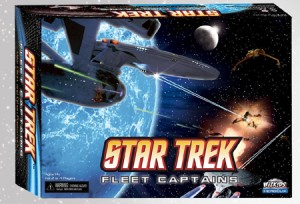 e next game review will be a non-Star Trek-themed game (even though the also-excellent Star Trek Deck Building Game from Bandai has just been released as of this review). Who’d have thought that in the space of just 4 months, we’d have not one, not two, but THREE great Star Trek games hit the shelves? It does my inner fanboy good.
e next game review will be a non-Star Trek-themed game (even though the also-excellent Star Trek Deck Building Game from Bandai has just been released as of this review). Who’d have thought that in the space of just 4 months, we’d have not one, not two, but THREE great Star Trek games hit the shelves? It does my inner fanboy good.
Unquestionably the biggest, baddest, snazziest, and, consequently, most expensive of the three by far is Wizkids’ magnum opus board game, Star Trek: Fleet Captains. Several years of development, multiple development versions, and a number of pushed-back release dates later, Star Trek fans have arguably the best tabletop representation of their universe ever created on their hands.
Now, sure, Michael, you say, I’m sure the game is great and all, but, I mean, come on! $100? For a board game? You’ve gotta be kidding me! Yes, this game will set you back a hundred smackers. But lets look at that pricetag like normal, rational human beings as we take a look at all the wonders that await inside the box. (are you excited yet? I am!)
COMPONENTS
Star Trek: Fleet Captains contains, in its truly gargantuan box, 350 cards. These cards are full color affairs, with (in most cases) a photo from one of the shows or movies in addition to the game text. They’re on fairly thin cardstock, but are vinyl-coated, to make them actually more durable then most traditional hobby cards. Now, before we look at any of the other great things in the box, let’s do a little math.
A booster pack of magic cards costs $3.99 nowadays, and contains 15 cards. Now, when you figure that price out per card, it comes to 26.6 cents per card. So, at 26.6 cents per card, 250 Magic cards would cost you $93.10 – almost the entire price of Fleet Captains. Now, admittedly, there are a few other concerns, most of which cancel each other out. The Magic cards are on a heavier, glossier cardstock, but the Fleet Captains cards are vinyl-coated for protection and durability. The Magic cards all have original artwork by some of the best fantasy artists in the industry today, but the Fleet Captains cards have those pesky Paramount licensing fees to consider. When you buy Magic cards, you have the chance to recoup your investment by getting a really rare card, but with Fleet Captains, you’re paying for al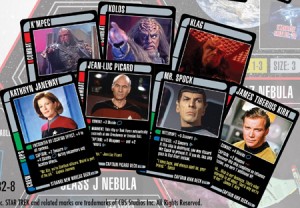 l the development of the game, which is long since paid for in Magic. All things being equal, Fleet Captains would not seem quite worth it simply for those cards – enough people are balking at the price as it is, but a lot of those same people regularly plop down their hard-earned duckets on full boxes of Magic cards, which, when you take all the other components of Fleet Captains into account, is a much lesser value.
l the development of the game, which is long since paid for in Magic. All things being equal, Fleet Captains would not seem quite worth it simply for those cards – enough people are balking at the price as it is, but a lot of those same people regularly plop down their hard-earned duckets on full boxes of Magic cards, which, when you take all the other components of Fleet Captains into account, is a much lesser value.
Now that the math lesson’s out of the way, let’s shift our attention to the rest of the box. We have 50 location tiles, which are the same material and thickness of the cards, but are larger, and hex shaped. We have around 200 cardboard chits, of varying game uses (I really can’t be bothered to count them right now), we have a pair of small dice, two thick cardboard “Consoles”, which basically just tell you where to put all the regular cards, and then we have the showpiece of the game (yeah, that’s right – that enormous amount of cards isn’t even the showpiece of the game!), the 24 exquisitely-detailed plastic ship miniatures, 12 each for the Federation and the Klingons. Now, these are awesome, but there are a few issues with them, and we’ll get those out of the way first.
Originally, as many people have loudly reminded Wizkids ever since the announcement came out to the contrary, the miniatures in Fleet Captains were supposed to arrive painted. This changed once Wizkids realized how much it was going to cost them to ship this game with painted miniatures, and how much they would have to charge for the game in turn. In the interest of keeping the game at something approaching a reasonable price, they sent them out unpainted, and really, its not as much of an issue as you think. The figures are all highly, highly detailed – definitely the best sculpting jobs I’ve ever seen for Star Trek miniatures in this scale, and the two sides are each a different color plastic – an off-white color for the Federation, and a dark olive green for the Klingons, so that right off the bat, despite being unpainted, the ships look pretty close, for the most part, to what they’re supposed to. In addition, the minis are made from a much harder, more brittle plastic, which, while it might annoy some people who are planning on playing them as is, is actually much better than the standard plastic Wizkids uses for their Heroclix line when it comes to painting the minis yourself (which I, of course, gleefully did). The other issue, sadly, is that the construction of the minis often leaves something to be desired. I’m sure this, like the painting, just ended up being a cost issue where corners had to be cut to make the game viable, but any given copy of the game will likely have nacelles which are bent to odd positions (and due to the plastic wizkids used, the only way to fix it would be to purposely break the piece off and reglue it properly), and for some people, I can understand this being something of a major issue. However, despite all this, believe me when I say that the included miniatures are simply phenomenal. They’d have been worth the purchase price to me just to use in other Trek games, but the fact that they have such a phenomenal game to back them up is just bonus.
THE GAME
There’s been a lot of Star Trek games over the years. For such a long-running and popular franchise, its not exactly surprising, but still – we’ve had everything from the intensely realistic naval-style wargaming of Star Fleet Battles to Decipher’s long-lived Star Trek Collectible Card Game (to which Fleet Captains shares more than a passing resemblance in its gameplay) to a number of themed Monopoly sets. Having played more of these than I care to admit throughout my lifetime, I can say with a certain degree of confidence – Star Trek: Fleet Captains, as a pure game, not taking any other elements into consideration, channels the essence of Trek better than any game to have come before it.
Setup begins by creating a modular board using the included location hexes, meaning that the “board” will be different every time you play (in fact, a standard two-player game only uses 20 of the 50 included hexes), and then drafting a fleet of ships from the 12 provided on each side. Each ship has a point value, so the length of the game can be adjusted by raising or lowering how many points worth of ships you and your opponent draft. The rules recommend drafting these ships randomly to increase replay value, but the game works just as well if you pick out which ships you want to use. You and your opponent will then each build your command decks. Each side has 100 command cards from which to choose – those cards are pre-separated into 10 10-card subdecks, and each player will choose 4 of them to shuffle together and use based on which ships they drew. While this is sometimes a pain during setup – separating out the 10 subdecks on each side, then effectively shuffling the 4 you choose together, then separating it all back again at the end of the game – it makes for a really simple and easy-to-use deck building mechanic that efficiently gives you a great amount of control over which cards you’ll draw in the game, without the intensive metagame of actually building a complete deck for each game (although one could theoretically do that with the cards provided). Each subdeck has its own theme, sometimes pertaining to the characters contained within the deck (The “Captain Picard” deck, or “House of Martok” deck, for instance), while others are named more after their function (like “Evasive Maneuvers” or “The Science of War”), so even those not terribly familiar with all of the cards can feel fairly confident in building their deck. These command cards, like every other aspect of the game, really, contribute greatly to the sense of theme pervading the game. You’ve got combat cards like Photon Torpedoes and the like to send off at your opponent, Ops cards like Sensor Pulse and Emergency Power, and Crew Cards featuring Kirk, Spock, Picard, Janeway, and the gang, who stay semi-permanently on your ships to provide various bonuses (I say semi-permanently because they all have some kind of effect you can discard them for, like how Spock can be discarded to save a ship he’s on from being completely destroyed – because you know, he has been, and always shall be, your friend).
Finally, players will draw a certain amount of missions from three different categories (Science, Combat, and Influence) to form their mission deck. The types of missions each player gets are determined by which ships they use – for instance, if you get a lot of science and exploration ships, those are the types of missions you’ll be doing.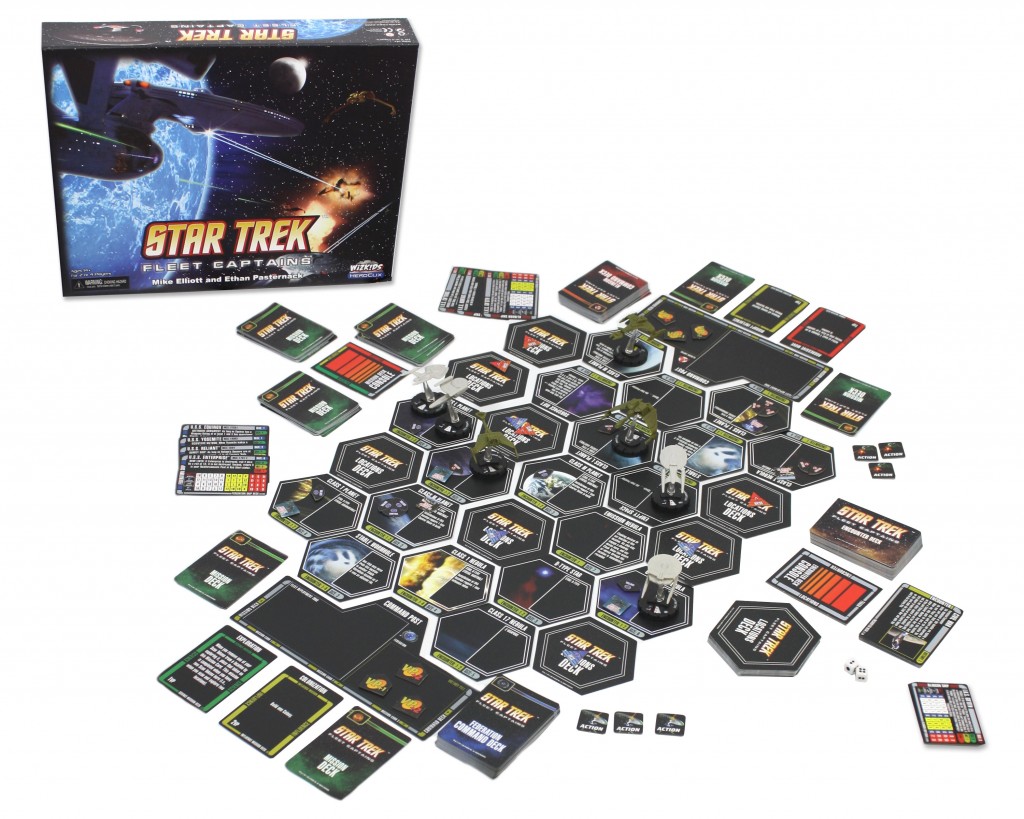
Once all the setup is complete, players will set out exploring the facedown location tiles and attempting to complete their missions in order to gain victory points. The number of victory points required to win is determined by how many points of ships each player is playing, and while there are other ways to gain victory points outside of just completing missions (destroying an enemy ship or building a starbase, for instance), missions will always be your primary source of victory points. The mission system is pure Trek – lots of people were expecting this game (myself included) to just be straight-up ship combat prior to its release, but I couldn’t be happier with the end result. In fact, its quite possible (I’ve already played a game this way) to go through an entire game, with plenty of player interaction even, without either side firing off a shot. However, despite how thematic it feels completing a mission to do an intensive sensor sweep of a pulsar with the USS Voyager, the real place where the game shines in the theme department is the encounter cards.
Each time you flip over a location tile, you’ll be faced with a range of numbers, and you’ll roll a die. If the die roll lands within the range of numbers, your ship’s movement will end and you’ll draw an encounter card. These range from everything from a visit from Q, to Sentient Nanites infesting your ship, to getting stuck in a Tyken’s Rift – even having your ship get infested with Tribbles, which can create a hilarious game of hot potato as you and your opponent each try and beam the Tribbles onto each others’ ships. These cards absolutely nail the feeling of Trek, as you get a sense of really hitting the “Strange New Worlds” part of Trek’s mission statement straight on the head.
Another unique aspect of the game design is how the miniatures are used. True to Wizkids form, the 24 minis in this box use their patented Clix bases, allowing the four different power values of each ship – weapons, sensors, engines, and shields, to be displayed in 12 different combinations around a rotating dial. Now, obviously, the Clix base itself is nothing new, but what is new is how its used in this game. Previously, the Clix base has only been used in various games to show a miniature getting weaker as it gets steadily damaged, click by click – however, in Fleet Captains, each ship has three different “Alert Statuses”, denoted by different colored backgrounds on the dial. As a ship is damaged once, it will move from the undamaged (white) section of its dial to the Yellow Alert (yellow) section of its dial, and from there to Red Alert (red) section of the dial, and from there straight on to explodo-land. Each alert level, though, consists of several clicks on the dial, and each click in a ships current Alert level can be cycled through once per turn to represent the transfer of power between different ships systems. For instance, one turn, you might need to set full power to engines to outrun a pesky Klingon Battlecruiser on your tail, and make it back to a starbase to repair. Another turn, you might need to set full sensors in order to scan a planet for signs of life. Still another, and you might need to do two things at once, and so choose a more balanced click. Its a great system for allowing you to manage power levels aboard your ships without all the intensive bookkeeping and micromanagement of a game like Star Fleet Battles.
THE VERDICT
Well, actually, if you’ve read the review up to this point, you pretty much already know the verdict, but if you skipped to the end (shame!) then I’ll fill you in – This is the best Trek game ever made, and one of the best hobby board games I’ve ever played. Don’t let the $100 pricetag scare you off, because if you did, you’d be missing a truly awesome feat of game development.
One last thing worth mentioning before I leave this page in peace, is the potential for expansion this game has. Wizkids has already more or less confirmed an expansion adding the Romulan faction to the mix at some point in the future, but even beyond that, there’s just so much room here for more command cards, more encounter cards, more ships, be they for new factions like the Romulans, Cardassians, Dominion, and Borg, or more stuff for the existing factions. If Wizkids plays their cards right, this could be a game with serious legs.
Until that time, though, live long and prosper.
Domino out.

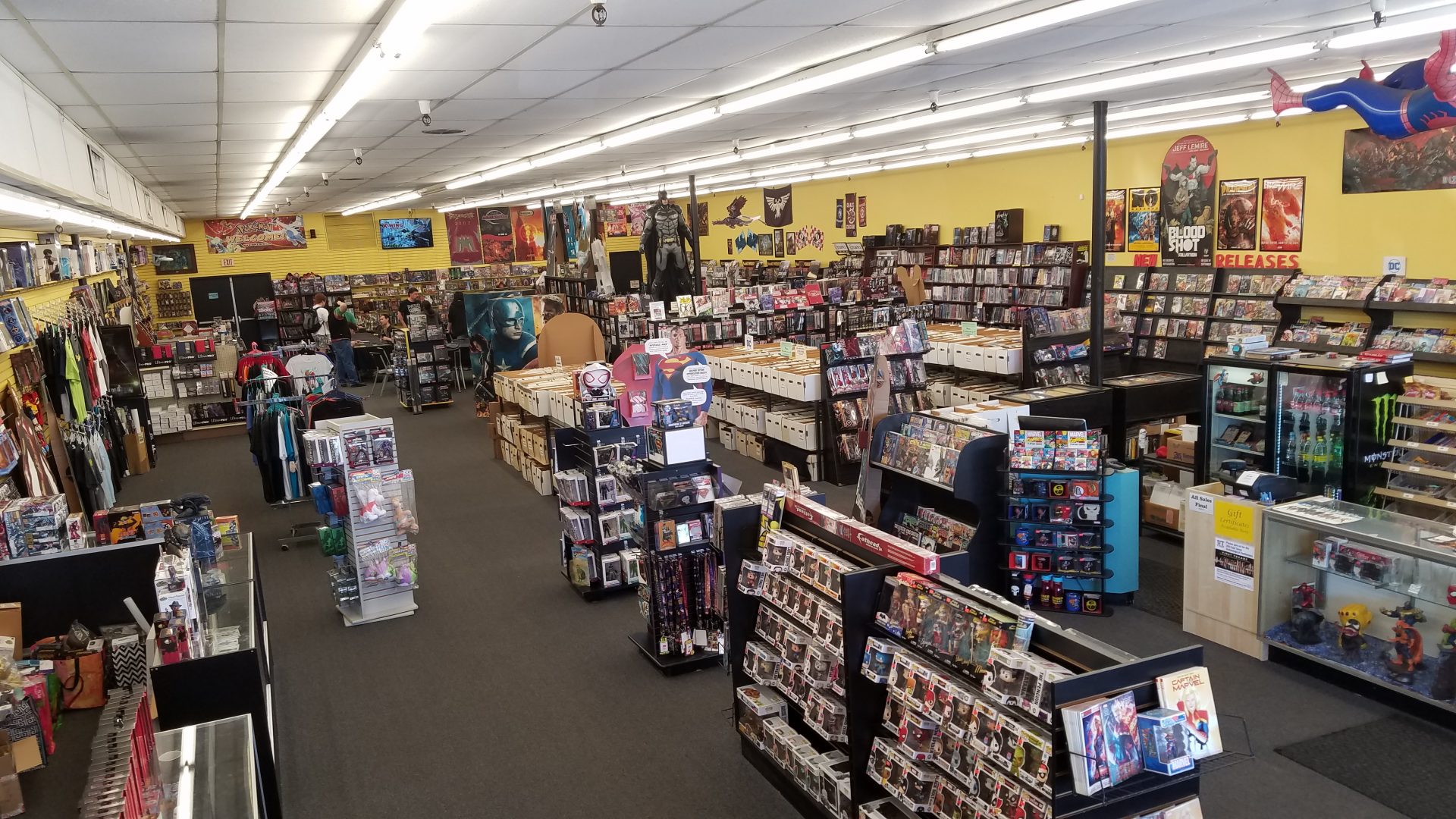
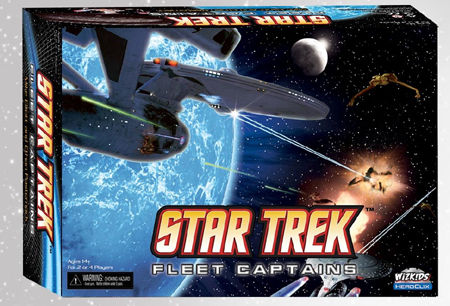
One thought on “Review – Star Trek: Fleet Captains”
Bravo, Mr. Domino (Hey! That rhymed!) on an article well written again!
Many of you don’t know this but I chastised Domino on his absence from the board not long ago & of course his reason was this set which (painting little toy spaceships) occupied much of his time. The wait was well worth it, because once again we have a review that shows not only the pros & cons of the given subject, but also has the effect of transferring the reviewer’s enthusiasm for this particular item to the reader.
Now, I have no interest in purchasing this board game (I know, I’m a cheap b@st*rd!) but it does amaze me that Wizard is releasing a game based upon a franchise that hasn’t been really been in the limelight since 2009 when JJ Abrams rebooted [b]Star Trek[/b]. Sure, I know that the next film is set to start shooting next year with a 2013 release date (if the impending apocalypse doesn’t claim us all; Perry/Palin-2012), but this is a $100 board game that is winning rave reviews from players…that’s an amazing feat in this day & age of video games. For me it is proof positive that fans (of any series, reboot or otherwise) are ready for the next installment of Star Trek; whether it be a television series or feature film starring the rebooted Next Generation, DS9 or Voyager crews…I think that fans want a return (something that I’ve said before) & Star Trek certainly has enough history/possibility to keep expanding.